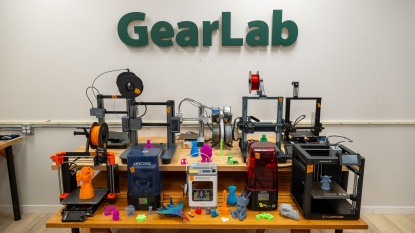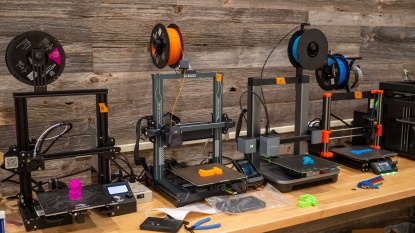Anycubic Photon Mono Review
Our Verdict
Our Analysis and Test Results
One thing to consider when looking at a resin printer is that the procedures for layout, orientation, and supports differ wildly from a filament printers, so you should also be prepared for some trial and error when you are just starting out — even if you have a decent amount of filament-based 3D printer experience already.
Print Quality
Our most important series of tests focused on the print quality of each 3D printer. For the resin printers, we made a different set of test prints than the FDM printers to get a better assessment of their performance head-to-head with each other, since the printing mechanisms differ by so much. The Mono did exceptionally well, earning one of the top scores of the entire group.
For these printers, we did a few benchmark tests designed just for resin printers, a model of the Eiffel Tower, a spiral tower with stairs, a hollow statue, some small figurines, a skull, and an icebreaker ship, as well as a few other models to compare performance.
The Mono did decently well in the first benchmark print but some of the thinnest features warped just a bit more than with some of the other ones. However, just about all of the other small features are very well-defined, even with the bridges and overhangs. The Eiffel Tower looks almost flawless, though it seems some of the smallest gaps got overexposed as they were filled — even after being thoroughly cleaned before post-curing.
The tower and the rook both came out great, with smoothly curving sections and small details that are defined very well. The words at the top were readable as well.
The icebreaker ship and the trio of smaller figurines also came out great, though the skull model did have some smaller gaps that got filled in.
Ease of Use
OUr next metric focused on the ease of printing with each 3D printer. The Anycubic Mono — like most resin printers — didn't fare the best in this category, earning a score well below average.
Luckily, it is an easier process to level the build plate on the Mono than many of the resin printers, as you just loosen the retaining screws, lower it down until it holds a piece of paper against the screen, re-zero it, and tighten the retaining screws. We generally found this to be much quicker and easier than a filament printer, where you are dealing with three or four different adjustment screws. It also is very easy to load resin, as you simply pour it into the vat — being careful not to overfill — and you are ready to go.
However, this is all assuming that your printer is clean. One of the reasons that makes resin printers more difficult to use is the need to clean them, which usually involves proper PPE and isopropyl alcohol. You'll also need to fully clean and wash your finished prints to remove uncured resin, then post-cure them under a UV light source for the resin to fully react and reach its peak mechanical properties.
All of this cleaning and curing leads to considerably more consumable materials that you need to have on hand to safely and effectively use your Mono, like paper towels, disposable gloves, isopropyl alcohol, filters for resin.
On top of all that, it can also be a bit of an art form when it comes to placing the supports in the slicing software for your models with resin printing. This isn't an insurmountable amount of work by any means but it is an order of magnitude more effort than most of the filament printers in our experience.
Print Capabilities
For our print capabilities metric, we looked at the build volume, build plate, compatible materials, and the different slicers that could be used to prepare files for each printer. The Anycubic Mono did decently well, earning a middle-of-the-road score.
This printer is compatible with the free Anycubic slicer, as well as a few other free and paid programs. We used the Anycubic slicer for testing and found it to be just about as easy to use and as capable as the typical resin slicing software.
The build volume on this printer is a little on the smaller side, topping out at 130mm x 80mm x 165mm. The build plate is anodized aluminum and we didn't struggle too much with any bed adhesion issues.
We do like that this printer is compatible with any 405 nm curing resin, regardless if it's made by Anycubic or a third-party.
Support
We looked at the available customer support for each of these printers for final metric, basing scores on how helpful the setup and troubleshooting information is and how responsive the manufacturer was to our questions. The Mono didn't do the best, earning a below-average score with its lackluster showing.
We found a few videos on the website that walk you through some maintenance and component replacement but not too much that actually deals with the slicing/printing/cleaning process.
They have a contact form to fill out but limited other ways to get in touch with customer service. We also found it to be quite difficult to elicit a response from them in our experience, so you might want to choose a different printer if you were planning on having a responsive manufacturer to regularly rely on.
Value
Fortunately, the Mono is one of the more budget-friendly options out there. However, you do need to consider the cost of all the consumables when you are looking at its value.
Conclusion
All in all, we think the Anycubic Mono is a great budget-friendly option for anyone trying to create very detailed prints on a smaller scale. There is a bit of a learning curve and a higher amount of effort required per print but you can get some downright astonishing prints on a miniature scale once you get the hang of it. It's not as versatile or beginner-friendly as a filament printer though, so beginners might want to check out some other models first.













